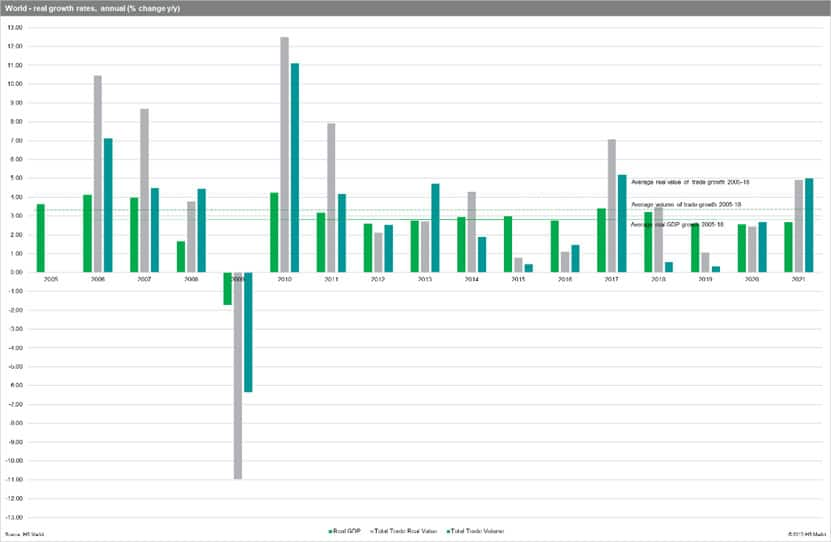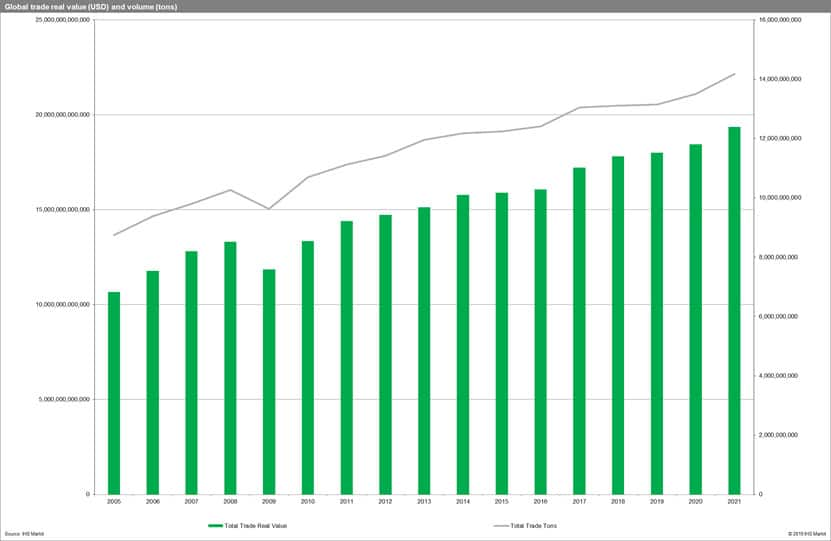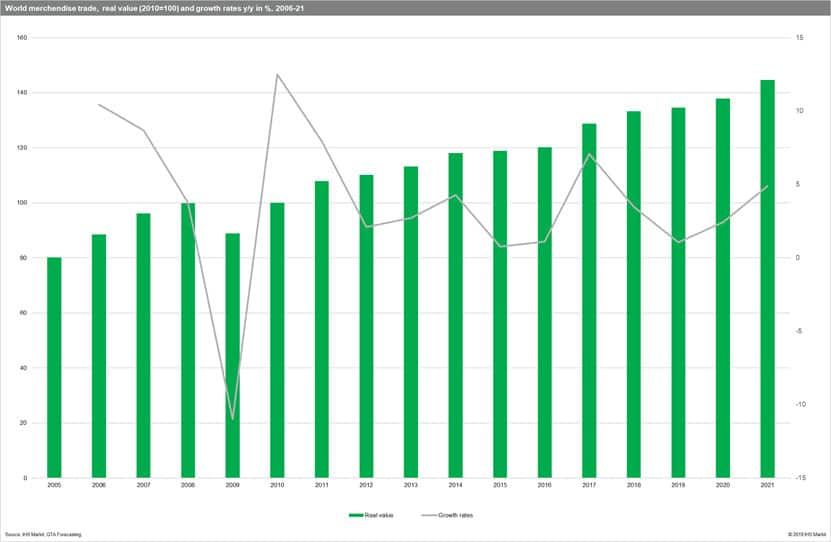Customer Logins
Obtain the data you need to make the most informed decisions by accessing our extensive portfolio of information, analytics, and expertise. Sign in to the product or service center of your choice.
Customer Logins
BLOG
Jan 02, 2020
Outlook for Global Trade in 2020
Author: Tomasz Brodzicki, Ph.D., Senior Economist II, IHS Markit Maritime & Trade
Key Points
- World merchandise trade volume is forecast to grow by 2.7% in 2020, accompanied by real GDP growth of 2.5%.
- Trade volume growth should increase to 5.0% in 2021 with GDP growth at 2.7%.
- The volume of global merchandise trade is forecasted to reach 14.175 billion tons in 2020 and 14.881 billion tons in 2021.
- The real value of global merchandise trade is predicted to reach USD 18.870 trillion in 2020 and USD 19.795 trillion in 2021.
- Trade tensions and overall trade policy uncertainty pose the greatest risk to our forecasts, but the expected lessening if implemented should provide some positive boosts.
Economic Growth and Trade Outlook
IHS Markit estimates show world real GDP growth slowing from 3.2% in 2018 to 2.6% in 2019 and 2.5% in 2020 and then picking up slightly to 2.7% in 2021. The world growth rates in 2019 and 2020 for real GDP, trade volume and real value are below CAGR for the period 2005 - 18 which is indicative of a global slowdown. The stronger recovery is visible in forecasts for 2021.

World merchandise trade volume is forecasted to grow 2.7% in 2020, and to grow by 5.0% in 2021. Trade volumes increased only by 0.6% in 2018 and 0.3% in 2019 reaching 13.758 bn tons and 13.804 bn tons respectively. Weaker trade performance in 2018 - 2019 reflected several factors: global trade tensions due to an increase in protectionism, significantly weaker global economic growth and higher levels of uncertainty in general.
Trade prospects for 2020 - 21
Despite sluggish global growth prospects, our models in Global Trade Atlas (GTA) Forecasting point to an increase in the real value of global trade both in 2020 and 2021 to respectively 18870.58 and 19794.77 USD billion. This translates into an increase of 38% in 2020 in comparison to 2010. The growth rates in the real value of world merchandise trade (year-on-year) are expected to be higher in 2020 in comparison to sluggish 2019. The forecasts for 2021 are even more optimistic (the growth rate expected to exceed the CAGR for 2005-18).


The volume of world merchandise trade is forecasted to go up by 2.7% in 2020 and 5.0% in 2021 to respectively 14175.8 and 14881.3 billion metric tons thus increasing demand for transport services. The growth rate in trade volume expected to exceed the CAGR for 2005-18 in 2021. The overall volume of world merchandise trade shows a clear upward trend over the period 2005 - 21 with 2009 as an exception followed by a quick recovery in the following years. The volume of world merchandise trade is changing, however, quite significantly by region. The following table shows the developments in trade volume in more detail. We forecast the highest growth rates in 2020 for South and North America - by 2.4 and 2.3% respectively. The lowest for Africa - only 0.3%. The prospects are much better for 2021 apart from Africa where the increase in trade volume is likely to mimic that of 2020.

Qualitative factors
We must acknowledge several key factors that can affect our global as well as regional forecast:
- Lower growth prospects for the US and Canada (2020-2021 - approx. 2%) and globally (2.54 in 2020 and 2.66 in 2021 according to IHS Markit macro-models) will affect export-led economies in particular;
- High uncertainty in global trade policy due to US-initiated protectionism and retaliatory actions by countries affected is likely to continue;
- The results of presidential elections in the US in November 2020 will be of key significance as they can potentially shift the heading of the US policy; the recent impeachment creates an extra dose of instability in the US political scene prior to the elections, however, the procedure is almost sure to be terminated by the Republican-dominated Senate;
- US trade tensions with China (high US-imposed punitive tariffs on Chinese exports and retaliatory actions by China) are likely to persist under the Trump administration;
- The trade war's impact will remain focused on China's exports to the US, and the related component exports from the rest of Asia to China (with few exceptions) - trade diversion is quite likely;
- The continuing trade conflict between the US and China can structurally alter global VCs apart from the already present precautionary shifts in global supply chains. At this stage appears to be working in the favor of economies such as Taiwan, Vietnam, and other parts of ASEAN-5 and some South American economies;
- In the ongoing US-China trade negotiations China pledged to spend between USD 40-50 billion on agricultural products annually as part of a deal to end the trade war and thus to remove extra tariffs imposed since last year on US farm products; If successfully implemented this could ease the pressure in mutual trade relations and positively affect global trade in 2020 - 21, however, taking into account the course of tensions in trade since the outset of the conflict in 2018 and the dynamics of bilateral negotiations, the probability of the actual implementation of the last results of negotiations should be considered rather low and thus are unlikely to significantly affect the forecasts at least for 2020;
- Upon the recent parliamentary vote results in the UK, Brexit at the end of January 2020 is on course; the no-agreement scenario is still possible, however, as it could bring adverse consequences for both the UK and EU the likelihood of that scenario is low (new custom checks and increasing trade frictions despite eventual agreement on a free-trade treaty);
- The European Council (on 13 Dec 2020) reiterated its commitment to an orderly withdrawal on the basis of the Existing Withdrawal Agreement and called for its timely ratification and effective implementation and reconfirmed its desire to establish as close as possible a future relationship with the UK (customs union); The trade negotiations are very likely to continue long post-Brexit with some interim measures in place;
- The paralysis of the multilateral dispute settlement system in the WTO is probable to last.
{"items" : [
{"name":"share","enabled":true,"desc":"<strong>Share</strong>","mobdesc":"Share","options":[ {"name":"facebook","url":"https://www.facebook.com/sharer.php?u=http%3a%2f%2fstage.www.spglobal.com%2fmarketintelligence%2fen%2fmi%2fresearch-analysis%2foutlook-for-global-trade-in-2020.html","enabled":true},{"name":"twitter","url":"https://twitter.com/intent/tweet?url=http%3a%2f%2fstage.www.spglobal.com%2fmarketintelligence%2fen%2fmi%2fresearch-analysis%2foutlook-for-global-trade-in-2020.html&text=Outlook+for+Global+Trade+in+2020+%7c+S%26P+Global+","enabled":true},{"name":"linkedin","url":"https://www.linkedin.com/sharing/share-offsite/?url=http%3a%2f%2fstage.www.spglobal.com%2fmarketintelligence%2fen%2fmi%2fresearch-analysis%2foutlook-for-global-trade-in-2020.html","enabled":true},{"name":"email","url":"?subject=Outlook for Global Trade in 2020 | S&P Global &body=http%3a%2f%2fstage.www.spglobal.com%2fmarketintelligence%2fen%2fmi%2fresearch-analysis%2foutlook-for-global-trade-in-2020.html","enabled":true},{"name":"whatsapp","url":"https://api.whatsapp.com/send?text=Outlook+for+Global+Trade+in+2020+%7c+S%26P+Global+ http%3a%2f%2fstage.www.spglobal.com%2fmarketintelligence%2fen%2fmi%2fresearch-analysis%2foutlook-for-global-trade-in-2020.html","enabled":true}]}, {"name":"rtt","enabled":true,"mobdesc":"Top"}
]}




